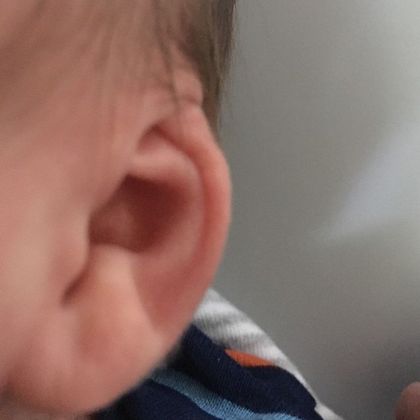For babies with cryptotia, ear molding can positively change their overall appearance. Parents of babies with cryptotia will often call the office and state that their “baby’s ear is buried under the scalp skin”. At Dr. Jandali’s office, he uses an external ear molding device to correct cryptotia and other ear deformities and set up your baby’s ear for proper development in life.
What Are Cryptotia Ear Deformities?
Cryptotia ear is also known as hidden ear or pocket ear. It’s an ear deformity that causes the upper portion of cartilage to be partially buried beneath the skin along the side of the head. Because the upper portion is hidden, it can also cause other areas of the ear to become distorted and malformed.
Like many baby ear problems, cryptotia ears don’t have a known cause. However, studies have shown that this condition occurs more often in people of Asian descent, with about 1 in 500 births. Cryptotia doesn’t affect your infant’s hearing, but it can affect their ability to wear eyeglasses or sunglasses in the future. Cryptotia can strongly affect your newborn’s self-esteem as they age.
Non-Surgical Correction in Babies with Cryptotia Ear Deformities
While it may appear that the cartilage is missing in cryptotia, it is actually underneath the skin. This means it can be retracted out from the surrounding skin and the skin can be expanded to reshape the ear. The best treatments for cryptotia ears involve separating the buried portion of the cartilage from the skin with non-surgical ear molding.
With ear molding, your baby’s cryptotia ear can be treated by stretching the skin, unburying the cartilage, and reshaping the ear. An EarWell prosthetic is placed along the upper helical rim and pulls the cartilage out from underneath the skin on the side of the head. The device is worn on your baby’s ears for at least four weeks in order to obtain a normal-looking appearance.
For parents seeking options for their newborn’s ear treatment, ear molding can be your solution. As the best non-surgical treatment option for baby ear problems, ear molding is considered highly successful due to its benefits:
- Responsive: High estrogen levels from the mother leads to the ears remaining soft and pliable. Over time they will decline to normal levels, and the ears will become less pliable.
- Painless: The cartilage that forms your baby’s ear is malleable and soft early after birth. This allows the molding process to have a high success rate while being painless for the newborn. The mold does not affect sleeping, lying on their side, nursing, or hearing development.
- Effective: After the first two weeks, the prosthetic device is removed to check the progress and make adjustments. Further treatment of two to four weeks is necessary to solidify the results and make them permanent.
- Non-Surgical: Non-invasive methods of treating ear deformities are an excellent option compared to more invasive approaches such as surgery. Treating them early can help ensure that your baby doesn’t need surgery later in life. This avoids the risks, scars, downtime, and recovery with ear shaping surgery. If cryptotia is not corrected non-surgically in the first few weeks after birth, it usually requires skin grafting to the ear in order to unbury the cartilage and lift it out from underneath the skin.
Dr. Jandali himself directly monitors your newborn’s progress with the non-surgical ear adjustment. It all begins with Dr. Jandali customizing an ear mold specifically designed to achieve the desired result in your baby. Many parents and their babies have benefited from his expertise and the babies have undergone custom ear molding for ear deformities.
Ear Molding for Newborns with Cryptotia Ear Deformities
If you have a newborn with cryptotia, then non-surgical ear molding is the best option for ear correction. Dr. Jandali offers non-surgical ear molding treatment for newborn cryptotia at his practice in Connecticut. For more information, contact Dr. Jandali’s office today to discuss your baby’s treatment options. If you wish to learn more, consult your pediatrician to learn whether your baby is a candidate for ear molding.
Cryptotia Ear Correction Gallery




